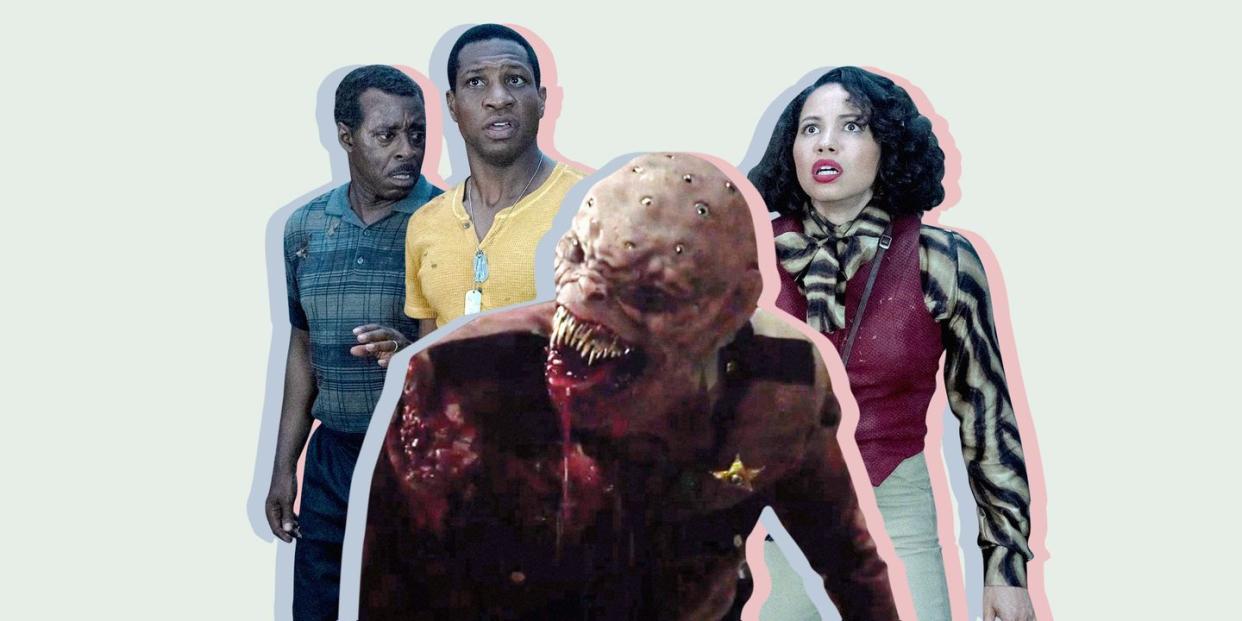A Guide to Monsters in 'Lovecraft Country': Cthulhus, Vampires, Ghouls, and More

Late in the first episode of Lovecraft Country, which debuted on HBO Sunday night, you’re watching a pretty intense standoff between Atticus, Leti, Uncle George, and a group of racist police officers. Until… freakish, scary-as-hell monsters jump out from the woods and slice one of the officers’ arms clean off. In the next couple minutes, we learn the monsters are sensitive to light, can make humans into monsters with so much as a bite, and are maybe/maybe-not vampires.
If you’re like me and knew an embarrassingly small amount about H.P. Lovecraft going into a show with his damn name in it, the sudden appearance of giant bear vampires is just a little bit disconcerting. Plus, since we don’t really get a legal name for the monsters, even, it’s hard to trace whatever the hell monster shows up in Lovecraft Country to a specific work of the late science fiction and horror writer. For legitimate days after watching the premiere, I bombarded Google with a vague smattering of Lovecraft, vampire, slobber, monster, teeth, and couldn’t really find much—until a colleague shared what must be the version of the Bible for Lovecraftian monsters with me.
Before we get to that: If you’re unfamiliar, Lovecraft’s work is full of cosmic entities called Cthulhus—which the writer described in “The Call of Cthulhu” as, "A monster of vaguely anthropoid outline, but with an octopus-like head whose face was a mass of feelers, a scaly, rubbery-looking body, prodigious claws on hind and fore feet, and long, narrow wings behind." The description resembles a remark Atticus makes in the forest, saying in the world of Lovecraft, the trees are filled with multi-eyed, octopus-esque creatures called blobs. But that doesn’t really match up with the monstrosities we saw in the first episode of Lovecraft Country.
Enter Petersen’s Field Guide to Cthulhu Monsters: A Field Oberver’s Handbook of Preternatural Entities, a book written in 1988 as an earnest field guide to the Cthulhus in Lovecraft’s work. Like, it’s written with the running bit that these things actually exist, and you would need this book to identify Cthulhus in the wild, Pokémon style. “These pages discuss 27 terrors of the hyper-geometrical realms, those which most concern us Earth-bound mortals,” the intro says. Pictures, descriptions of each Cthulhu’s name and abilities, everything an intrepid monster enthusiast would want.
Turns out this obscure field guide from the ’80s is a pretty damn helpful companion to Lovecraft Country. There’s not a 100 percent match with what we see in the show—which seems to blend elements of different Cthulhus into one. There’s some truly terrifying shit in here (don’t look at the Formless Spawn if you want to sleep tonight), but I took the almost 30-question-long quiz at the beginning of the book (Is it invisible? Is it obviously tentacled? Does the creature have a vaguely oclopoid head and bat-like wings, and is it of immense size?), and this is the Cthulhu the book pointed me toward.
While I was a little tripped up by the question asking if the beast had mold on its butt or not (we don’t get the best look at the Lovecraft monster’s ass), the field guide offered a close-ish match with the Ghoul. From our trusty handbook: “Not completely human, though it often approaches human likeness, the Ghoul is roughly bipedal, with a slouching, vaguely canine aspect, which includes a rubbery hide, pointed ears, a mould·caked body, half-hooved feet, and scaled claws used for burrowing.”
Sounds like as close as we’re gonna get! Though the Hound of Tindalous (“long, sinuous tongue and drips a putrid substance like blue puss”) was a close second. The book doesn’t mention light sensitivity, but says Ghouls are nocturnal, and most definitely have a penchant for ripping limbs from other creatures. The field guide adds, too, that the whole human-into-monster-bite thing is most definitely a thing: “Ghoul physiology may include a moral fetor or venom which gradually causes or aids human transformation into monsterhood.” Plus, Ghouls are even known to kidnap and raise human babies as Ghouls. How nice.
Anyway. That was a fun journey. This is all, probably, a massive mindfuck for those of you who are devoted viewers of Sunday night HBO. Meaning your last series was also a slow-burning period drama: Perry Mason, hold the monsters. Now, that would be a mashup I’d pay to see—Lovecraft Country and Perry Mason, Perry getting his ass beat by Cthulhus, trying to figure out why Flying Polyps and the Servitor of the Outer Gods keep tormenting Los Angeles.
You Might Also Like

